|
The
bordermarkers of the
Pyrenees : Llivia
|
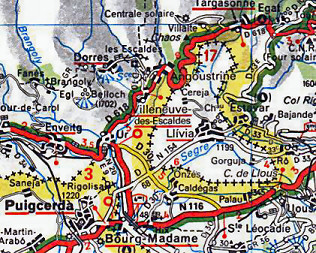 Llivia
is a Spanish enclave in the French Pyrenees. It remained Spanish
because of its city-rights obtained in the past. Llivia is demarcated
by 45 bordermarkers. For pictures of the bordermarkers, go to this page Llivia
is a Spanish enclave in the French Pyrenees. It remained Spanish
because of its city-rights obtained in the past. Llivia is demarcated
by 45 bordermarkers. For pictures of the bordermarkers, go to this pageLlivia is situated 1 km from the Spanish border en about 20 km east from Andorra. It's size is 12 square km and the village of Llivia has 1200 inhabitants. History In roman times Llivia was an important place in the region. In the middle ages a castle was built on the hill above the village (now ruined). Puigcerda, just across the current Spanish boundary, had become the primary town in the Cerdagne, which belonged as a whole to Spain. For what ever reason, Llivia received city rights from the Spanish king which turned out to be crucial in later days. In 1659 the Spanish-French border was established in the treaty of the Pyrenees. In the treaty of Llivia (1660) the half of Cerdagne including 33 villages was given to France. Spain however refused to hand over Llivia, simply because it was a city and not a village. That's how Llivia became an enclave. 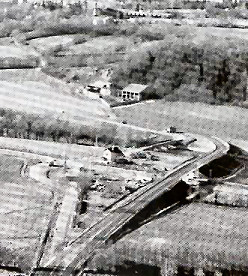 Border problems Border problemsLlivia is connected by a neutral road (D68) with Spain and this road was until 1995 forbidden for foreign cars. The crossing with the French N20 was dangerous but the Spanish didn't accept in the seventees the right of way of the N20. They insisted on a unhindered connection between Llivia and the spanish mainland. The French Stop-signs were often being demolished in this "guerre des stops". In the end a viaduct was built, payed by the Spanish government. The picture shows the viaduct in construction with Puigcerda on the background. The same problem occurred with the crossing with the D30 but here a roundabout was constructed in 2001. 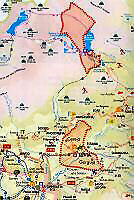 As
a compensation for becoming an enclave, Llivia received in property a
large French area to the west of the lake of Bouillouses, meant for
cattle and forestry. The building of a french hotel (l'hôtel Bones
Hores) on this property led to many civil courts between France and
Spain. As a result, the hotel will become Llivian property in 2030.
Another area - to the east of the lake - was lost in 1831 by a court
decision. As
a compensation for becoming an enclave, Llivia received in property a
large French area to the west of the lake of Bouillouses, meant for
cattle and forestry. The building of a french hotel (l'hôtel Bones
Hores) on this property led to many civil courts between France and
Spain. As a result, the hotel will become Llivian property in 2030.
Another area - to the east of the lake - was lost in 1831 by a court
decision.Bordermarkers See the pictures, starting at this page The exact demarcation of the French-Spanish border was undertaken in 1868. About 600 bordermarkers were placed along the border. Llivia got his own range of 45 bordermarkers. See the Treaties-page for the delimitation-act. Until then the municipal border of Llivia was considered as the international border but there were many conflicts. One centuries-old stone however (Pedra Detra, on the spot of the current marker nr. 1) was recognized on both sides as a border marker. From the proceedings of this meeting of the Commission Mixte d'Abornement we learn that in 2000-2001 the following maintenance was undertaken: - the placement of 1, 17 and 31 - the replacement of 2, 3 and 14 - the replacement of 8, 17 and 31bis - the extra marking of 3 and 8 with wooden poles. 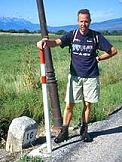 On my first trip in 2002 with co-walker Bert (see picture) from marker 1 to
21 we could experience in depth that the border is often crossing
through the middle of fields. We saw older border stones but also brand
new ones. On the Llivian side there was always painted/carved "LL", on
the other side we saw several different letters (C, CSL, SL, S, E)
which we could link to the surrounding French villages (Caldégas,
Ste-Léocadie, Saillagouse en Estavar).
On my first trip in 2002 with co-walker Bert (see picture) from marker 1 to
21 we could experience in depth that the border is often crossing
through the middle of fields. We saw older border stones but also brand
new ones. On the Llivian side there was always painted/carved "LL", on
the other side we saw several different letters (C, CSL, SL, S, E)
which we could link to the surrounding French villages (Caldégas,
Ste-Léocadie, Saillagouse en Estavar).In 2004 on a holiday with 'copine' Karin, the bordermarkers 13 & 15 were revisited (bad pictures in 2002) and 23 and 45 easily found. The project was completed in september 2005 on two long solo-hikes from Puigcerda. The bordermarkers 24, 26 & 27 were unfindable. However: in 2009 Martial Garcia reported me that he found those missing bordermarkers. And he provided additional information about bm29 and the double markers 31-32-33-34. In july 2010 I returned to photograph bordermarkers 24, 26 and 27 and in 2013 there was a new survey of most bordermarkers. Some links http://freepages.misc.rootsweb.com/~hughwallis/Llivia/ Hugh Wallis' report on his bordermarker trip in Llivia http://eric.hurtebis.chez-alice.fr/llivia.htm General webpage on Llivia (French) http://www.amigosdelciclismo.com/rutas/catalunya/girona/llivia/home.htm A bicycle route around Llivia (Spanish) http://paconudels.blogspot.com/ Paco Nudels shows most of the Lliva-bordermarkers, using pictures of Charles and Joséphine Darrieu Maps 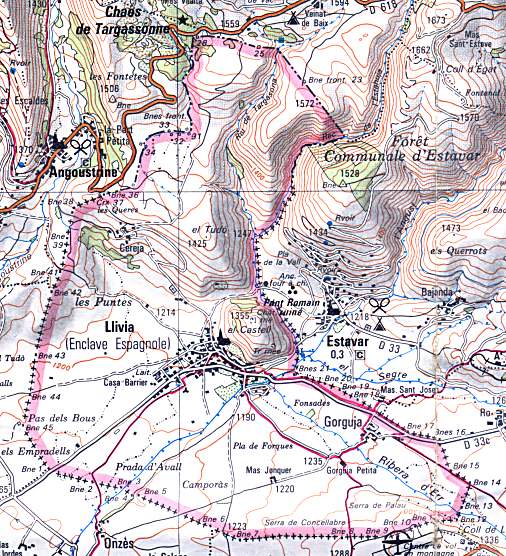 1:50.000 map. For a full scan (1266x1389, 0,7Mb) click here 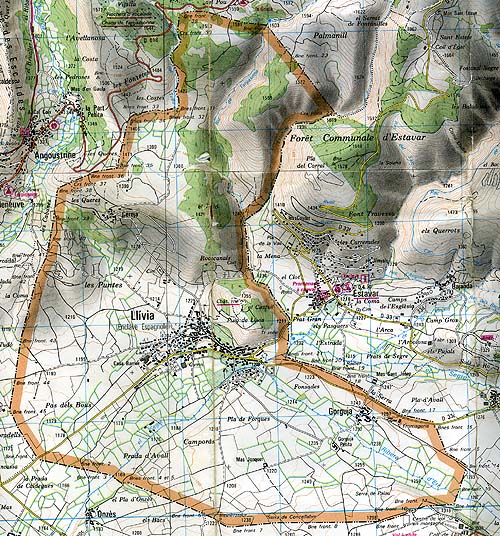 1:25.000 map. For a full scan (1471x1571, 0,9Mb) click here 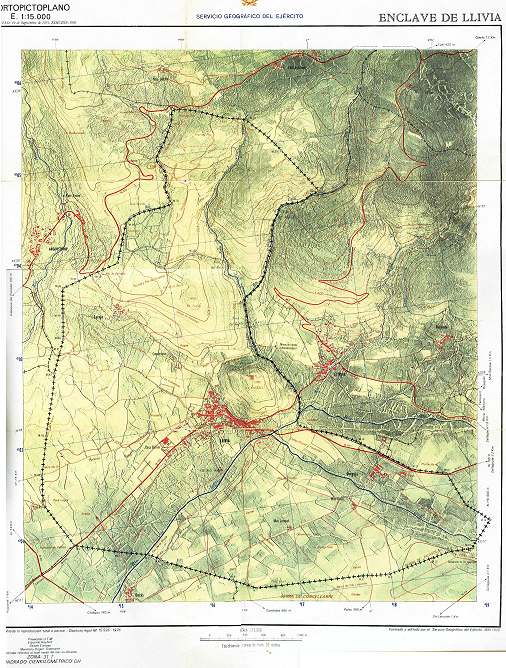
For a full scan (2412x3186, 1,6Mb) click here |
